Regulation of Amylose Content by Single Mutations at an Active Site in the Wx-B1 Gene in a Tetraploid Wheat Mutant
Abstract
1. Introduction
2. Results
2.1. Identification of the Wx-B1 Null Mutant
2.2. Identification of Causal Mutations in M3-415
2.3. Measurement of Total Grain Proteins
2.4. Modification of the ADPG Binding Pocket in the M3-415 Mutant
2.5. Evaluation of Starch-Binding Capabilities
2.6. Expression Pattern of the Wx Gene
2.7. Measurement of Enzymatic Activity in the M3-415 Mutant
2.8. Physicochemical Properties of Starch in M3-415 Grains
2.9. Starch Granule Characterization
3. Discussion
4. Materials and Methods
4.1. Materials
4.2. Electrophoresis of Wx Proteins and Extraction of Total Grain Proteins
4.3. Cloning of the Wx-B1 Gene
4.4. Site-Directed Mutagenesis
4.5. Expression and Purification of GBSSI Protein
4.6. GBSSI Starch-Binding Assay
4.7. Real-Time Quantitative PCR (qRT-PCR) Analysis
4.8. GBSSI Enzymatic Activity Assay
4.9. Starch Content Test
4.10. Determination of the Gelatinization Characteristics of Starch in Urea
4.11. Determination of the Thermal Properties of Starch
4.12. Analysis of Starch Granule Morphology
5. Conclusions
Supplementary Materials
Author Contributions
Funding
Institutional Review Board Statement
Informed Consent Statement
Data Availability Statement
Conflicts of Interest
References
- Kabbaj, H.; Sall, A.T.; Al-Abdallat, A.; Geleta, M.; Amri, A.; Filali-Maltouf, A.; Belkadi, B.; Ortiz, R.; Bassi, F.M. Genetic diversity within a global panel of durum wheat (Triticum durum) landraces and modern germplasm reveals the history of alleles exchange. Front. Plant Sci. 2017, 8, 1277. [Google Scholar] [CrossRef] [PubMed]
- Slim, A.; Piarulli, L.; Kourda, H.C.; Rouaissi, M.; Robbana, C.; Chaabane, R.; Pignone, D.; Montemurro, C.; Mangini, G. Genetic structure analysis of a collection of Tunisian durum wheat germplasm. Int. J. Mol. Sci. 2019, 20, 13. [Google Scholar] [CrossRef] [PubMed]
- Ma Zzucotelli, E.; Sciara, G.; Ma Strangelo, A.M.; Desiderio, F.; Bassi, F.M. The Global Durum Wheat Panel (GDP): An international platform to identify and exchange beneficial alleles. Front. Plant Sci. 2020, 11, 569905. [Google Scholar] [CrossRef] [PubMed]
- Matsuoka, Y. Evolution of polyploid Triticum wheats under cultivation: The role of domestication, natural hybridization and allopolyploid speciation in their diversification. Plant Cell Physiol. 2011, 52, 750–764. [Google Scholar] [CrossRef]
- Rahman, S.; Li, Z.; Batey, I.; Cochrane, M.; Appels, R.; Morell, M. Genetic alteration of starch functionality in wheat. J. Cereal Sci. 2000, 31, 91–110. [Google Scholar] [CrossRef]
- Hannah, L.C.; James, M. The complexities of starch biosynthesis in cereal endosperms. Curr. Opin. Biotechnol. 2008, 19, 160–165. [Google Scholar] [CrossRef]
- Yamamori, M.; Nakamura, T.; Endo, T.; Nagamine, T. Waxy protein deficiency and chromosomal location of coding genes in common wheat. Theor. Appl. Genet. 1994, 89, 179–184. [Google Scholar] [CrossRef]
- Kaur, A.; Shevkani, K.; Katyal, M.; Singh, N.; Ahlawat, A.K.; Singh, A.M. Physicochemical and rheological properties of starch and flour from different durum wheat varieties and their relationships with noodle quality. J. Food Sci. Technol. 2016, 53, 2127–2138. [Google Scholar] [CrossRef]
- Samaan, J.; El-Khayat, G.H.; Manthey, F.A.; Fuller, M.P.; Brennan, C.S. Durum wheat quality: II. The relationship of kernel physicochemical composition to semolina quality and end product utilisation. Int. J. Food Sci. Technol. 2006, 41, 47–55. [Google Scholar] [CrossRef]
- Sano, Y. Differential regulation of waxy gene expression in rice endosperm. Theor. Appl. Genet. 1984, 68, 467–473. [Google Scholar] [CrossRef]
- Shapter, F.M.; Eggler, P.; Lee, L.S.; Henry, R.J. Variation in granule bound starch synthase I (GBSSI) loci amongst Australian wild cereal relatives (Poaceae). J. Cereal Sci. 2009, 49, 4–11. [Google Scholar] [CrossRef]
- Nakamura, T.; Yamamori, M.; Hirano, H.; Hidaka, S. Identification of three Wx proteins in wheat (Triticum aestivum L.). Biochem. Genet. 1993, 31, 75–86. [Google Scholar] [CrossRef]
- Newberry, M.; Berbezy, P.; Belobrajdic, D.; Chapron, S.; Tabouillot, P.; Regina, A.; Bird, A. High-amylose wheat foods: A new opportunity to meet dietary fiber targets for health. Cereal Foods World 2018, 63, 188–193. [Google Scholar]
- Baik, B.K.; Park, C.; Paszczynska, B.; Konzak, C. Characteristics of noodles and bread prepared from double-null partial waxy wheat. Cereal Chem. 2003, 80, 627–633. [Google Scholar] [CrossRef]
- Sharma, R.; Sissons, M.; Rathjen, A.; Jenner, C. The null-4A allele at the waxy locus in durum wheat affects pasta cooking quality. J. Cereal Sci. 2002, 35, 287–297. [Google Scholar] [CrossRef]
- Yamamori, M.; Quynh, N. Differential effects of Wx-A1,-B1 and-D1 protein deficiencies on apparent amylose content and starch pasting properties in common wheat. Theor. Appl. Genet. 2000, 100, 32–38. [Google Scholar] [CrossRef]
- Busi, M.V.; Palopoli, N.; Valdez, H.A.; Fornasari, M.S.; Wayllace, N.Z.; Gomez-Casati, D.F.; Parisi, G.; Ugalde, R.A. Functional and structural characterization of the catalytic domain of the starch synthase III from Arabidopsis thaliana. Proteins Struct. Funct. Bioinform. 2008, 70, 31–40. [Google Scholar] [CrossRef]
- Momma, M.; Fujimoto, Z. Interdomain disulfide bridge in the rice granule bound starch synthase I catalytic domain as elucidated by X-ray structure analysis. Biosci. Biotechnol. Biochem. 2012, 76, 1591–1595. [Google Scholar] [CrossRef]
- Sheng, F.; Jia, X.; Yep, A.; Preiss, J.; Geiger, J.H. The crystal structures of the open and catalytically competent closed conformation of Escherichia coli glycogen synthase. J. Biol. Chem. 2009, 284, 17796–17807. [Google Scholar] [CrossRef]
- Schwarte, S.; Brust, H.; Steup, M.; Tiedemann, R. Intraspecific sequence variation and differential expression in starch synthase genes of Arabidopsis thaliana. BMC Res. Notes 2013, 6, 1–14. [Google Scholar] [CrossRef]
- Sheng, F.; Yep, A.; Feng, L.; Preiss, J.; Geiger, J.H. Oligosaccharide binding in Escherichia coli glycogen synthase. Biochemistry 2009, 48, 10089–10097. [Google Scholar] [CrossRef]
- Mason-Gamer, R.J.; Weil, C.F.; Kellogg, E.A. Granule-bound starch synthase: Structure, function, and phylogenetic utility. Mol. Biol. Evol. 1998, 12, 1658–1673. [Google Scholar] [CrossRef]
- Botticella, E.; Sestili, F.; Hernandez-Lopez, A.; Phillips, A.; Lafiandra, D. High resolution melting analysis for the detection of EMS induced mutations in wheat Sbella genes. BMC Plant Biol. 2011, 11, 1–14. [Google Scholar] [CrossRef]
- Greene, E.A.; Codomo, C.A.; Taylor, N.E.; Henikoff, J.G.; Till, B.J.; Reynolds, S.H.; Enns, L.C.; Burtner, C.; Johnson, J.E.; Odden, A.R. Spectrum of chemically induced mutations from a large-scale reverse-genetic screen in Arabidopsis. Genetics 2003, 164, 731–740. [Google Scholar] [CrossRef]
- Krieg, D.R. Ethyl methanesulfonate-induced reversion of bacteriophage T4rII mutants. Genetics 1963, 48, 561. [Google Scholar] [CrossRef]
- Li, S.; Zhong, X.; Zhang, X.; Rahman, M.M.; Jiang, Q. Production of waxy tetraploid wheat (Triticum turgidum durum L.) by EMS mutagenesis. Genet. Resour. Crop Evol. 2020, 67, 2. [Google Scholar] [CrossRef]
- Ahloowalia, B.; Maluszynski, M.; Nichterlein, K. Global impact of mutation-derived varieties. Euphytica 2004, 135, 187–204. [Google Scholar] [CrossRef]
- Slade, A.J.; Knauf, V.C. Tilling moves beyond functional genomics into crop improvement. Transgenic Res. 2005, 14, 109–115. [Google Scholar] [CrossRef]
- Guzmán, C.; Alvarez, J.B. Wheat waxy proteins: Polymorphism, molecular characterization and effects on starch properties. Theor. Appl. Genet. 2016, 129, 1–16. [Google Scholar] [CrossRef]
- Saito, M.; Vrinten, P.; Ishikawa, G.; Graybosch, R.; Nakamura, T. A novel codominant marker for selection of the null Wx-B1 allele in wheat breeding programs. Mol. Breed. 2009, 23, 209–217. [Google Scholar] [CrossRef][Green Version]
- Ayala, M.; Alvarez, J.B.; Yamamori, M.; Guzmán, C. Molecular characterization of waxy alleles in three subspecies of hexaploid wheat and identification of two novel Wx-B1 alleles. Theor. Appl. Genet. 2015, 128, 2427–2435. [Google Scholar] [CrossRef] [PubMed]
- Zhang, L.L.; Chen, H.; Luo, M.; Zhang, X.W.; Deng, M.; Ma, J.; Qi, P.F.; Wang, J.R.; Chen, G.Y.; Liu, Y.X. Transposon insertion resulted in the silencing of Wx-B1n in Chinese wheat landraces. Theor. Appl. Genet. 2017, 130, 1321–1330. [Google Scholar] [CrossRef] [PubMed]
- Luo, M.; Ding, J.; Li, Y.; Tang, H.; Qi, P.; Ma, J.; Wang, J.; Chen, G.; Pu, Z.; Li, W. A single-base change at a splice site in Wx—A1 caused incorrect RNA splicing and gene inactivation in a wheat EMS mutant line. Theor. Appl. Genet. 2019, 132, 2097–2109. [Google Scholar] [CrossRef] [PubMed]
- Coutinho, P.M.; Deleury, E.; Davies, G.J.; Henrissat, B. An evolving hierarchical family classification for glycosyltransferases. J. Mol. Biol. 2003, 328, 307–317. [Google Scholar] [CrossRef]
- Tatge, H.; Marshall, J.; Martin, C.; Edwards, E.A.; Smith, A.M. Evidence that amylose synthesis occurs within the matrix of the starch granule in potato tubers. Plant Cell Environ. 2010, 22, 543–550. [Google Scholar] [CrossRef]
- Wang, S.; Hassani, M.E.; Crossett, B.; Copeland, L. Extraction and identification of internal granule proteins from waxy wheat starch. Starch Stärke 2013, 65, 186–190. [Google Scholar] [CrossRef]
- Tetlow, I.J.; Beisel, K.G.; Cameron, S.; Makhmoudova, A.; Liu, F.; Bresolin, N.S.; Wait, R.; Morell, M.K.; Emes, M.J. Analysis of protein complexes in wheat amyloplasts reveals functional interactions among starch biosynthetic enzymes. Plant Physiol. 2008, 146, 1878–1891. [Google Scholar] [CrossRef]
- Liu, F.; Romanova, N.; Lee, E.A.; Ahmed, R.; Evans, M.; Gilbert, E.P.; Morell, M.K.; Emes, M.J.; Tetlow, I.J. Glucan affinity of starch synthase IIa determines binding of starch synthase I and starch-branching enzyme IIb to starch granules. Biochem. J. 2012, 448, 373–387. [Google Scholar] [CrossRef]
- Seung, D.; Soyk, S.; Coiro, M.; Maier, B.A.; Eicke, S.; Zeeman, S.C. Protein targeting to starch is required for localising granule-bound starch synthase to starch granules and for normal amylose synthesis in Arabidopsis. PLoS Biol. 2015, 13, e1002080. [Google Scholar] [CrossRef]
- Yasui, T.; Seguchi, M.; Ishikawa, N.; Fujita, M. Starch properties of a waxy mutant line of hull-less barley (Hordeum vulgare L.). Starch Stärke 2002, 54, 179–184. [Google Scholar] [CrossRef]
- Sasaki, T.; Yasui, T.; Matsuki, J. Effect of amylose content on gelatinization, retrogradation, and pasting properties of starches from waxy and nonwaxy wheat and their F1 seeds. Cereal Chem. 2000, 77, 58–63. [Google Scholar] [CrossRef]
- Sanders, E.; Thompson, D.; Boyer, C. Thermal behavior during gelatinization and amylopectin fine structure for selected maize genotypes as expressed in four inbred lines. Cereal Chem. 1990, 67, 594–602. [Google Scholar]
- Jane, J.; Chen, Y.; Lee, L.; McPherson, A.; Wong, K.; Radosavljevic, M.; Kasemsuwan, T. Effects of amylopectin branch chain length and amylose content on the gelatinization and pasting properties of starch. Cereal Chem. 1999, 76, 629–637. [Google Scholar] [CrossRef]
- Kumar, R.; Khatkar, B.S. Thermal, pasting and morphological properties of starch granules of wheat (Triticum aestivum L.) varieties. J. Food Sci. Technol. 2017, 548, 2403–2410. [Google Scholar] [CrossRef]
- Naguleswaran, S.; Vasanthan, T.; Hoover, R. The susceptibility of large and small granules of waxy, normal and high-amylose genotypes of barley and corn starches toward amylolysis at sub-gelatinization temperatures. Food Res. Int. 2013, 51, 771–782. [Google Scholar] [CrossRef]
- Feillet, P.; Ait-Mouh, O.; Kobrehel, K.; Autran, J.-C. The role of low molecular weight glutenin proteins in the determination of cooking quality of pasta products: An overview. Cereal Chem. 1989, 66, 26–30. [Google Scholar]
- Matsuo, R. Effect of protein content on the cooking quality of spaghetti. Cereal Chem. 1972, 49, 707–711. [Google Scholar]
- Dexter, J. Effect of starch on pasta dough rheology and spaghetti cooking quality. Cereal Chem. 1979, 56, 190–195. [Google Scholar]
- Gianibelli, M.; Sissons, M.; Batey, I.; Panozzo, E.J.; Ratcliffe, M.; Wootton, M.; Wrigley, C. Effect of different waxy starches on pasta cooking quality of durum wheat. Cereal Chem. 2005, 82, 321–327. [Google Scholar] [CrossRef]
- Park, C. Evaluation and establishment of selection criteria for high grain quality of Korean winter wheat (Triticum aestivum L.). Ph.D. Thesis, Korea University, Seoul, Korea, 2000. [Google Scholar]
- Niu, M.; Hou, G.G.; Zhao, S. Dough rheological properties and noodle-making performance of non-waxy and waxy whole-wheat flour blends. J. Cereal Sci. 2017, 75, 261–268. [Google Scholar] [CrossRef]
- Yamamori, M.; Endo, T. Variation of starch granule proteins and chromosome mapping of their coding genes in common wheat. Theor. Appl. Genet. 1996, 93, 275–281. [Google Scholar] [CrossRef]
- Hurkman, W.J.; Tanaka, C.K. Extraction of wheat endosperm proteins for proteome analysis. J. Chromatogr. B 2007, 849, 344–350. [Google Scholar] [CrossRef]
- Murray, M.; Thompson, W.F. Rapid isolation of high molecular weight plant DNA. Nucleic Acids Res. 1980, 8, 4321–4326. [Google Scholar] [CrossRef]
- Valdez, H.A.; Busi, M.V.; Wayllace, N.Z.; Parisi, G.; Ugalde, R.A.; Gomez-Casati, D.F. Role of the N-terminal starch-binding domains in the kinetic properties of starch synthase III from Arabidopsis thaliana. Biochemistry 2008, 47, 3026–3032. [Google Scholar] [CrossRef]
- Liu, F.; Makhmoudova, A.; Lee, E.A.; Wait, R.; Emes, M.J.; Tetlow, I.J. The amylose extender mutant of maize conditions novel protein–protein interactions between starch biosynthetic enzymes in amyloplasts. J. Exp. Bot. 2009, 60, 4423–4440. [Google Scholar] [CrossRef]
- Liu, L.; Ma, X.; Liu, S.; Zhu, C.; Jiang, L.; Wang, Y.; Shen, Y.; Ren, Y.; Dong, H.; Chen, L. Identification and characterization of a novel Waxy allele from a Yunnan rice landrace. Plant Mol. Biol. 2009, 71, 609–626. [Google Scholar] [CrossRef]
- Liu, D.R.; Huang, W.X.; Cai, X.L. Oligomerization of rice granule-bound starch synthase 1 modulates its activity regulation. Plant Sci. 2013, 210, 141–150. [Google Scholar] [CrossRef]
- Ross, A.; Willson, V.L. Basic and Advanced Statistical Tests: Writing Results Sections and Creating Tables and Figures; Springer: New York, NY, USA, 2018. [Google Scholar]
- Nishi, A.; Nakamura, Y.; Tanaka, N.; Satoh, H. Biochemical and genetic analysis of the effects of amylose-extender mutation in rice endosperm. Plant Physiol. 2001, 127, 459–472. [Google Scholar] [CrossRef]
- Cai, Y.; Li, S.; Jiao, G.; Sheng, Z.; Wu, Y.; Shao, G.; Xie, L.; Peng, C.; Xu, J.; Tang, S. Os PK 2 encodes a plastidic pyruvate kinase involved in rice endosperm starch synthesis, compound granule formation and grain filling. Plant Biotechnol. J. 2018, 16, 1878–1891. [Google Scholar] [CrossRef]
- Nakata, M.; Miyashita, T.; Kimura, R.; Nakata, Y.; Takagi, H.; Kuroda, M.; Yamaguchi, T.; Umemoto, T.; Yamakawa, H. MutMapPlus identified novel mutant alleles of a rice starch branching enzyme II b gene for fine-tuning of cooked rice texture. Plant Biotechnol. J. 2018, 16, 111–123. [Google Scholar] [CrossRef]
- Barrera, G.N.; Calderón-Domínguez, G.; Chanona-Pérez, J.; Gutiérrez-López, G.F.; León, A.E.; Ribotta, P.D. Evaluation of the mechanical damage on wheat starch granules by SEM, ESEM, AFM and texture image analysis. Carbohydr. Polym. 2013, 98, 1449–1457. [Google Scholar] [CrossRef] [PubMed]
- Chia, T.; Adamski, N.M.; Saccomanno, B.; Greenland, A.; Nash, A.; Uauy, C.; Trafford, K. Transfer of a starch phenotype from wild wheat to bread wheat by deletion of a locus controlling B-type starch granule content. J. Exp. Bot. 2017, 68, 5497–5509. [Google Scholar] [CrossRef] [PubMed]
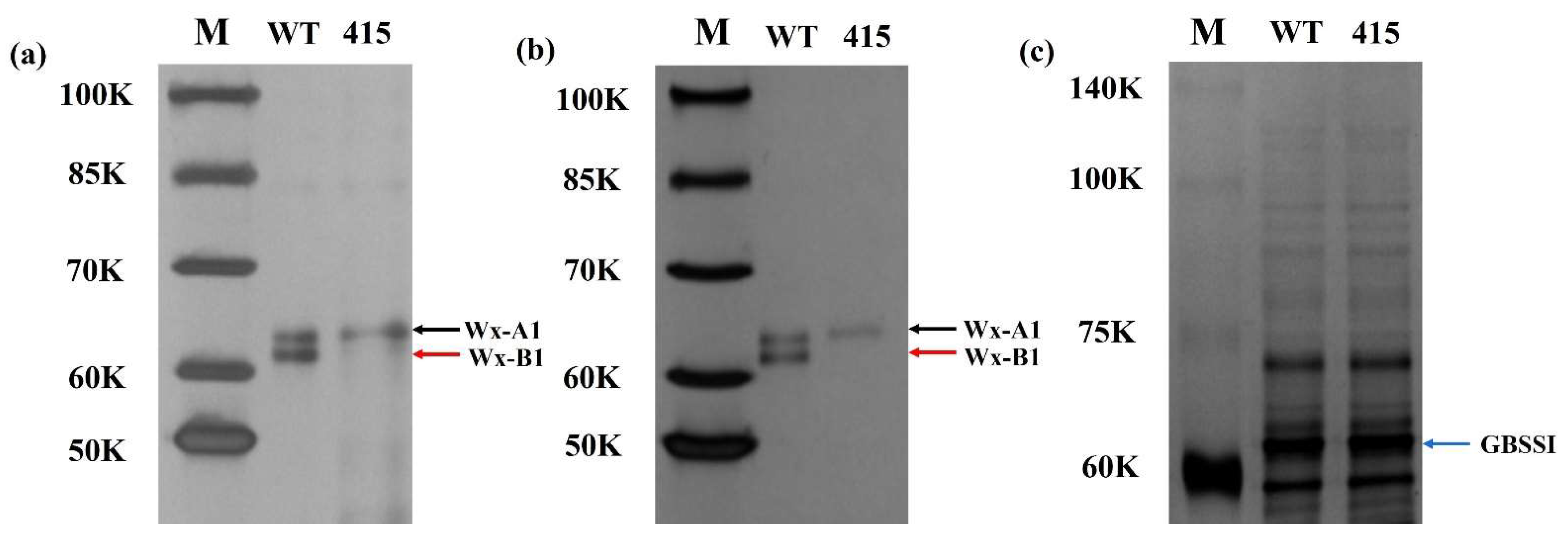
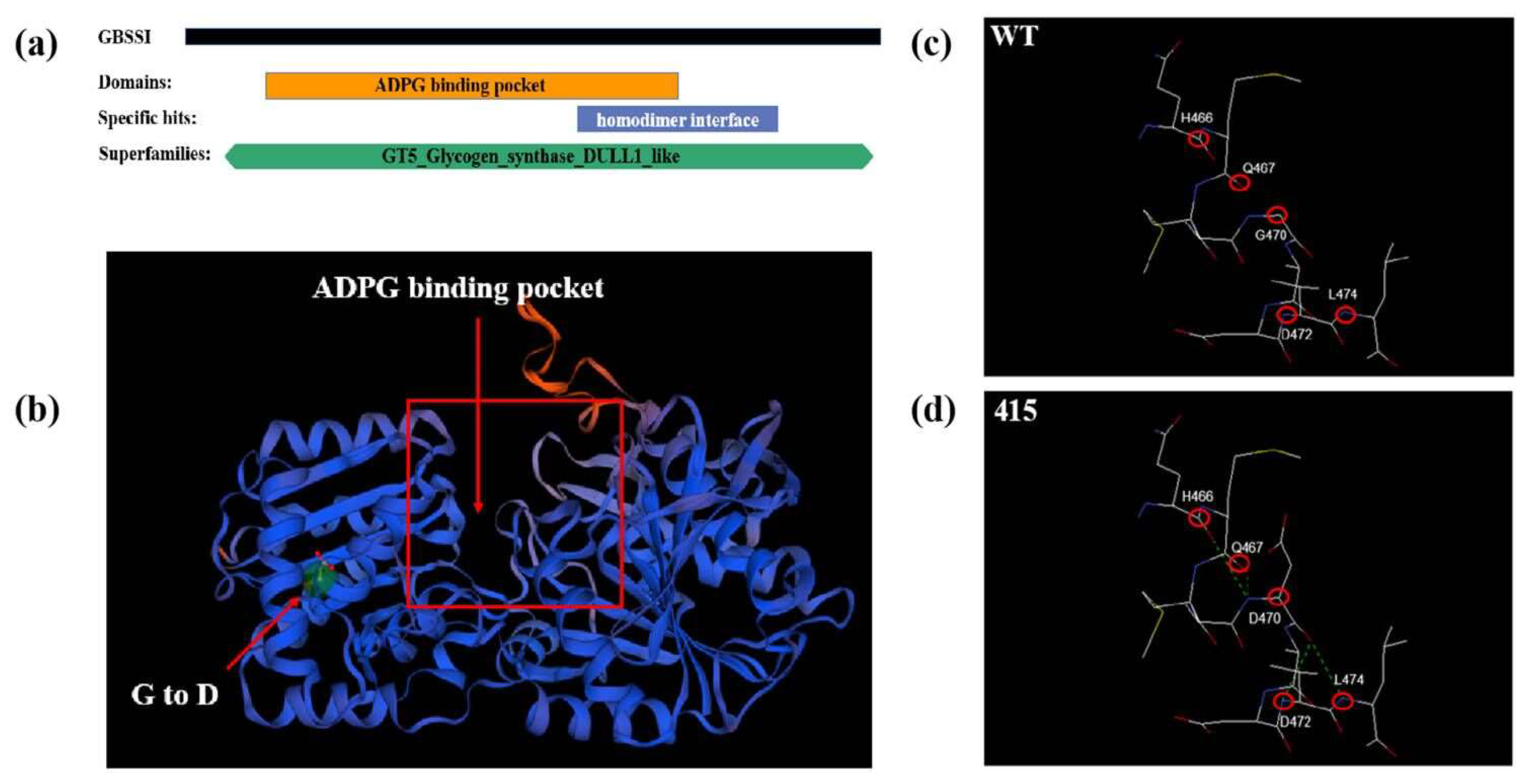
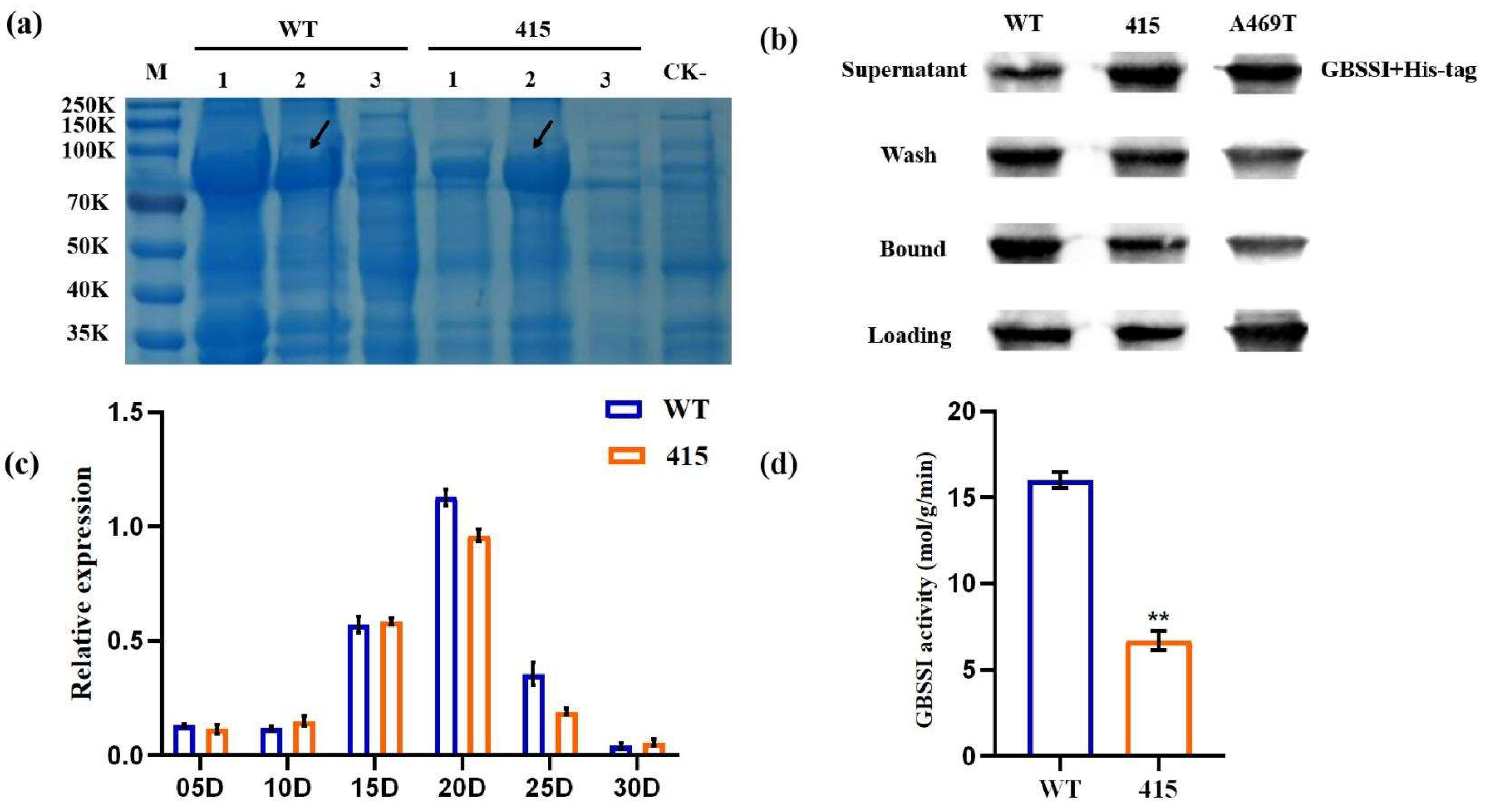
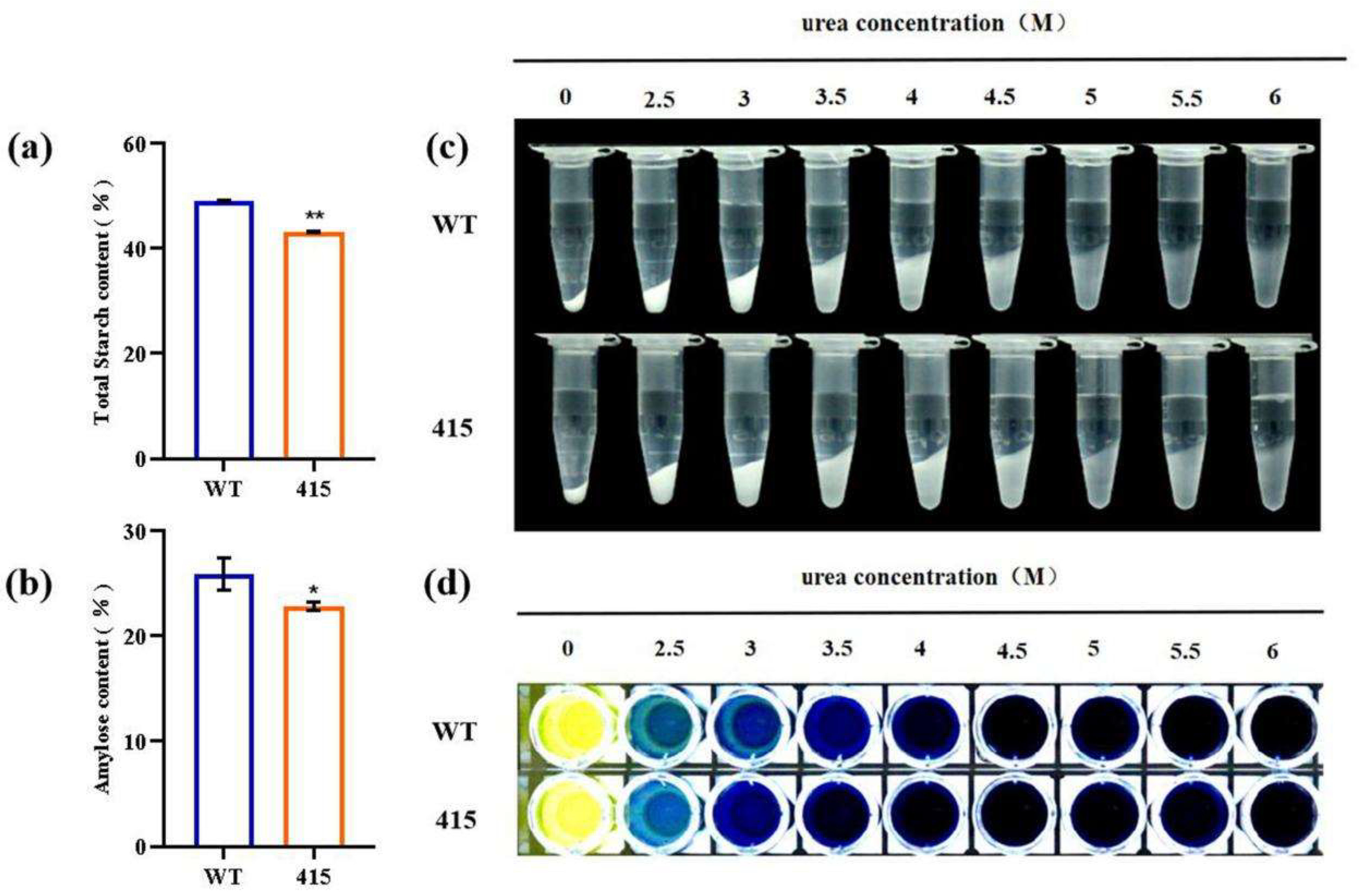
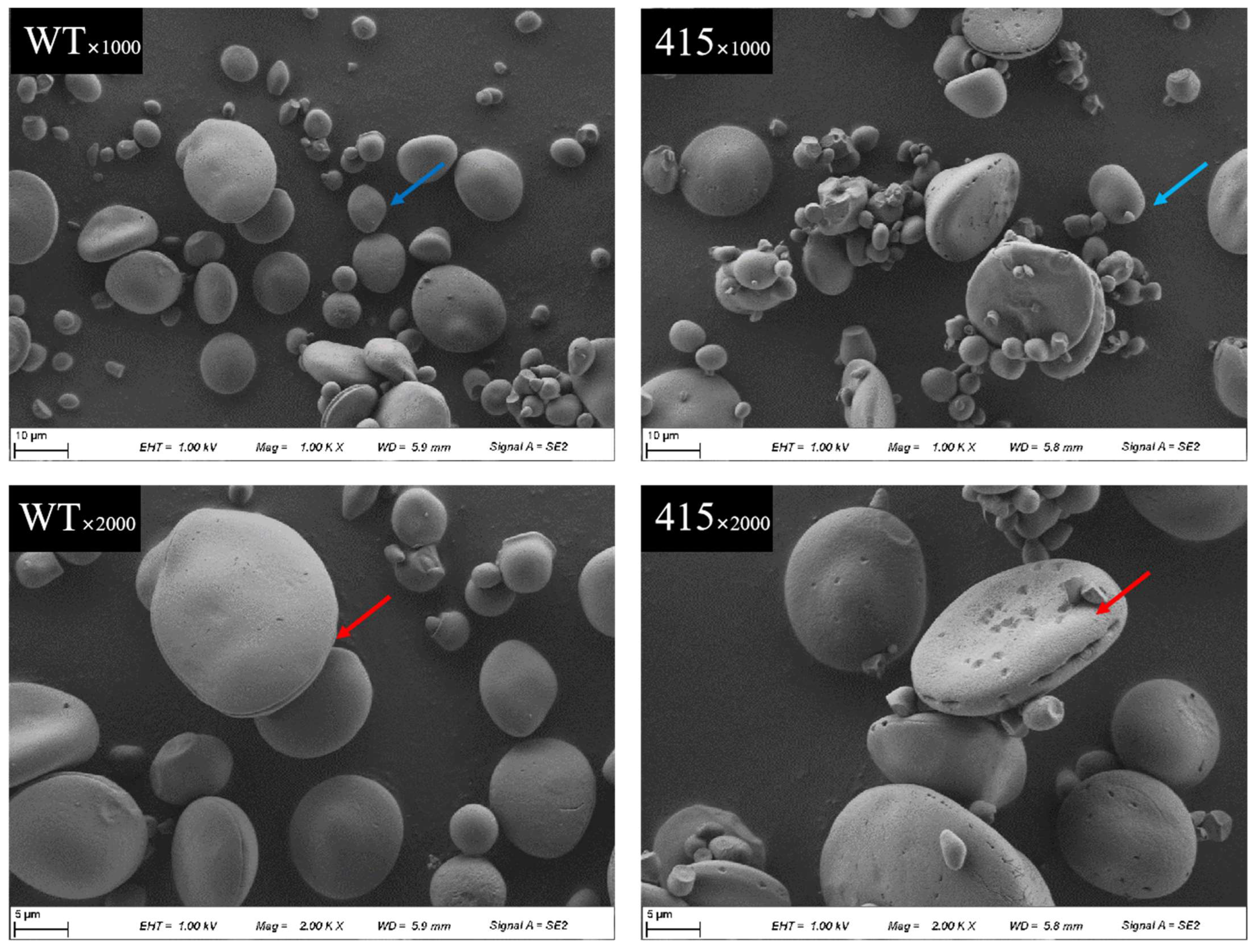
| Protein | SAAS | Predicted Score a | Predicted Class | Observed Class |
|---|---|---|---|---|
| Wx-B1 | G470D | 0.999 | Functional | Functional |
| Accession | To (°C) | Tp (°C) | Tc (°C) | ΔH (J/g) |
|---|---|---|---|---|
| WT | 62.73 ± 0.56 | 65.54 ± 0.48 | 76.73 ± 0.59 | 3.607 ± 0.28 |
| 415 | 62.49 ± 0.12 | 67.22 ± 0.28 ** | 77.93 ± 0.36 ** | 6.262 ± 0.39 ** |
| Granule Content—Number (%) | Granule Content—Volume (%) | |||
|---|---|---|---|---|
| Line | A-type | B-type | A-type | B-type |
| WT | 0.23 | 99.74 | 56.84 | 35.29 |
| 415 | 0.23 | 99.79 | 58.58 * | 39.13 ** |
Publisher’s Note: MDPI stays neutral with regard to jurisdictional claims in published maps and institutional affiliations. |
© 2022 by the authors. Licensee MDPI, Basel, Switzerland. This article is an open access article distributed under the terms and conditions of the Creative Commons Attribution (CC BY) license (https://creativecommons.org/licenses/by/4.0/).
Share and Cite
Li, Y.; Karim, H.; Wang, B.; Guzmán, C.; Harwood, W.; Xu, Q.; Zhang, Y.; Tang, H.; Jiang, Y.; Qi, P.; et al. Regulation of Amylose Content by Single Mutations at an Active Site in the Wx-B1 Gene in a Tetraploid Wheat Mutant. Int. J. Mol. Sci. 2022, 23, 8432. https://doi.org/10.3390/ijms23158432
Li Y, Karim H, Wang B, Guzmán C, Harwood W, Xu Q, Zhang Y, Tang H, Jiang Y, Qi P, et al. Regulation of Amylose Content by Single Mutations at an Active Site in the Wx-B1 Gene in a Tetraploid Wheat Mutant. International Journal of Molecular Sciences. 2022; 23(15):8432. https://doi.org/10.3390/ijms23158432
Chicago/Turabian StyleLi, Yulong, Hassan Karim, Bang Wang, Carlos Guzmán, Wendy Harwood, Qiang Xu, Yazhou Zhang, Huaping Tang, Yunfeng Jiang, Pengfei Qi, and et al. 2022. "Regulation of Amylose Content by Single Mutations at an Active Site in the Wx-B1 Gene in a Tetraploid Wheat Mutant" International Journal of Molecular Sciences 23, no. 15: 8432. https://doi.org/10.3390/ijms23158432
APA StyleLi, Y., Karim, H., Wang, B., Guzmán, C., Harwood, W., Xu, Q., Zhang, Y., Tang, H., Jiang, Y., Qi, P., Deng, M., Ma, J., Lan, J., Wang, J., Chen, G., Lan, X., Wei, Y., Zheng, Y., & Jiang, Q. (2022). Regulation of Amylose Content by Single Mutations at an Active Site in the Wx-B1 Gene in a Tetraploid Wheat Mutant. International Journal of Molecular Sciences, 23(15), 8432. https://doi.org/10.3390/ijms23158432









